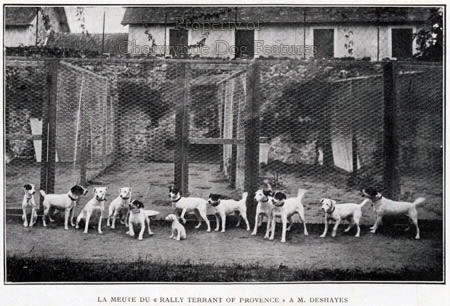871 TERRIERS - BRITAIN'S GIFT TO THE SPORTING WORLD
TERRIERS! BRITAIN'S GIFT TO THE SPORTING WORLD
by David Hancock


The terriers as a functional group are essentially British, with the distinguished breeds from Scotland, Ireland and Wales combining with those of England to give the canine world the much-loved terrier breeds valued everywhere. The terrier function has long been sought here, leading in time to the different breeds emerging as local preferences made their mark. A long history is often claimed for breeds of terrier, but I doubt if terrier men in past centuries ever bothered much about pure breeding. In his The Book of all Terriers of 1971, John Marvin writes: "Despite claims made by writers who champion the antiquity of several of today's Terrier breeds, years of careful research have failed to disclose a single reference to any reproducible breed prior to 1800. In fact, the only deviations from the earliest descriptions are variations noted as to coat, size and legs." So much for the search for ancient history in our long-established breeds of terrier!
 - La chasse sous terre.jpg)
 - La chasse sous terre.jpg)
In his Field Sports of 1760, terriers are described by William Daniel as being of two sorts, one of them rough, short-legged, long backed and very strong, usually black or light tan colour, mixed with white. The other was said to be smooth-haired and more pleasingly formed, with a shorter body and a more athletic appearance, usually reddish-brown or black with tan legs. Prototypes of subsequent breeds are hinted at here. French and German writers of previous centuries have made reference to dogs functioning as terriers, not just Dachshund types but Pinschers and Schnauzers too. We may have captured the terrier breed market but not the terrier function. But when earth-dogs are needed overseas, it is customary for our native breeds of terrier to outdo any local type, in France for example, the Fox Terrier has long been preferred as their sporting terrier of choice. It may well be that France is now the home of the sporting Fox Terrier.
 - La chasse sous terre.jpg)

Varieties of our recognised terrier breeds have surfaced in overseas countries too, as the now-distinct breeds of Japanese, Brazilian, Tenterfield, Australian and American Toy Terriers demonstrate. It is easy to spot the British terrier blood that led to the creation of such breeds. I can recall a Forstmeisster in Germany telling me how his grandfather recounted how 'terriers from England' were imported to further develop their German Hunt Terrier, now an accepted pedigree breed, and finding favour here. Certainly, when you look at the German Hunt Terriers now owned here, you can soon spot signs of their being shaped by terriers from the north of England. I have seen Fell Terriers that could pass as the German breed in any show ring. When a Czech terrier enthusiast wanted to create his own terrier breed, he soon resorted, in his Cesky Terrier to the blood of our Sealyham. There may soon be more of the former in Britain than the latter, such is our fascination with all things exotic.


Encouragingly, our emergent breeds of sporting terrier, such as the Plummer, Lucas and Sporting Lucas Terrier breeds, as well as the northern types of Patterdale and Fell Terrier, have now replaced the KC-registered terrier breeds so spoiled by show-ring excess and no longer fit for purpose. It is such a pleasure to see the fiery-red coated Plummer doing so well, when the Scottish breeds of terrier have been lost to the sporting world. It is so encouraging to talk to the devotees of the perky little Sporting Lucas Terrier - especially after seeing the over-coated specimens in the breeds of Skye, Scottish and Dandie Dinmont Terrier. The Irish terrier breeds have their problems too; I see poorly-coated Irish Terriers, too heavily-boned Glen of Imaal Terriers and over-coated Kerry Blues at KC shows. The fall of the Sealyham as a sporting terrier seems to be being addressed with a more field type emerging. But I haven't seen an impressive Welsh Terrier for some time, despite their once-good reputation in Welsh sporting circles. Terrier breeds, it seems, come and go!


Regrettably, exaggerations in dogs with a closed gene pool always end up exaggerating themselves. Out-crossing to restore true type may be regarded as sacrilege by conformists. But why, once attracted to a breed, not honour its true blueprint? Why betray its original type and true form? Sadly, most show breeders are extraordinarily conformist, even when true breed type in their favoured breed is threatened. But, whatever the country of origin, the breed-title, the lack of literature or the show ring follies behind the terrier type, this group of dogs deserves our admiration, not just for their valuable work in vermin control but for their effect on our spirit; it is difficult to be depressed, idle or bored when terriers are about. Their sheer joie de vivre lightens our day, their renowned tenacity can inspire us and their sustained curiosity can shame us into comparable activity. May we have terriers, whatever the title, with us for a very long time.